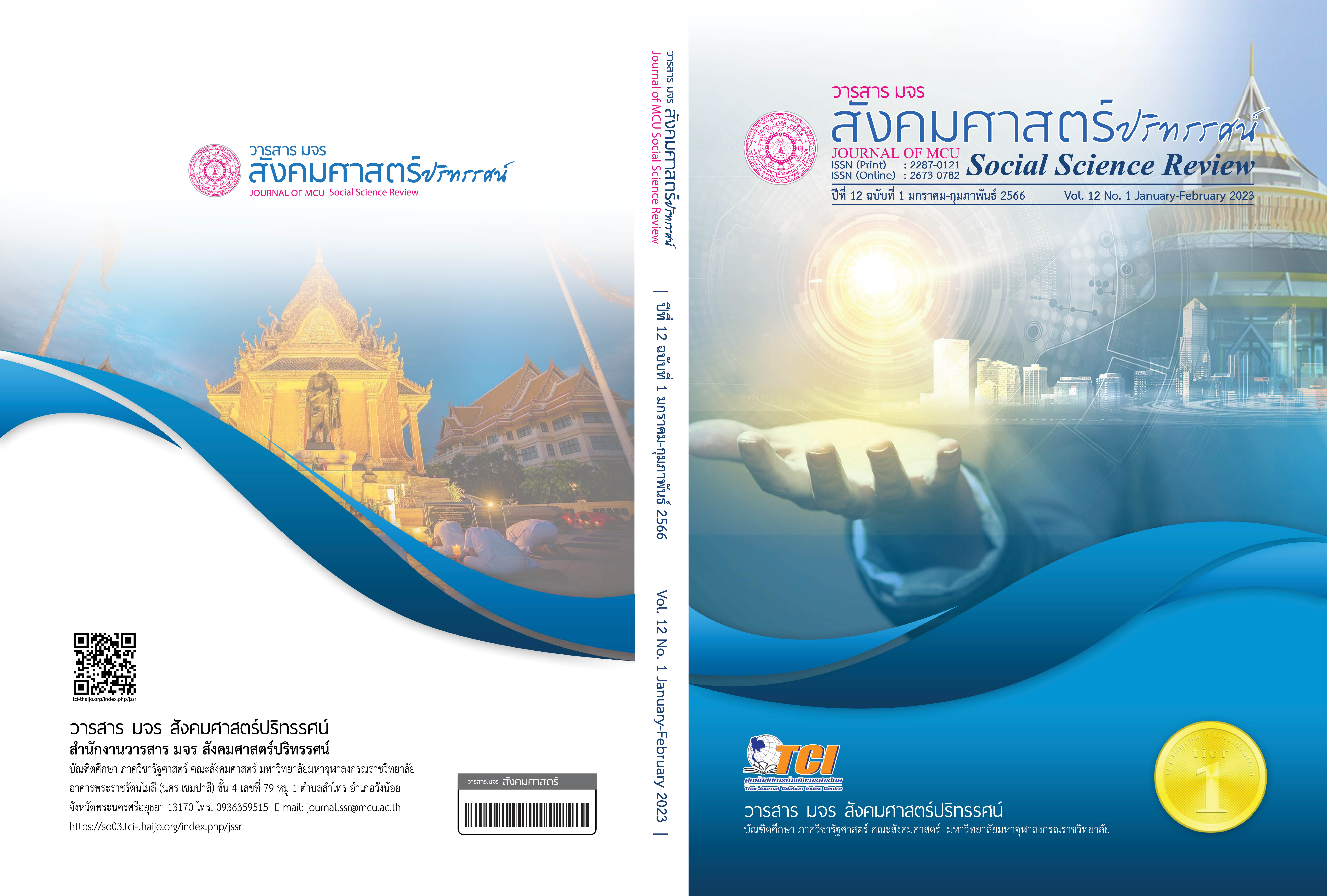กบฏผู้มีบุญในภาคอีสาน พ.ศ.2444-2445
คำสำคัญ:
กบฏผู้มีบุญ, รัชกาลที่ 5, มณฑลอีสานบทคัดย่อ
การศึกษาเรื่องกบฏผู้มีบุญหรือผีบุญในภาคอีสาน พ.ศ.2444-2445 เป็นการศึกษาเหตุการณ์ในประวัติศาสตร์ของไทยที่สำคัญเป็นเหตุการณ์ที่เกิดขึ้นในสมัยรัชกาลที่ 5 เรื่องราวของกบฏที่สืบเนื่องกันมาในเวลายาวนาน กบฏผีบุญหรือผู้มีบุญกระทำโดยประชาชนในวงพื้นที่กว้างและเป็นจำนวนมาก ภาคอีสานเป็นภาคที่มีกบฏมากกว่าทุกภาคของประเทศไทย ในเขตมณฑลอีสาน มณฑลอุดรและมณฑลนครราชสีมา และฝั่งซ้ายแม่น้ำโขง พวกกบฏผู้มีบุญมีวิธีขยายความเชื่อเพื่อให้คนเข้าร่วมกลุ่มให้มากที่สุด ซึ่งโอกาสที่เกิดการกบฏเช่นนี้น้อยมากในสังคมชาวนา โดยอาศัยข้อมูลทางประวัติศาสตร์ไทยมาทำการศึกษาพฤติกรรมทางการเมืองของกลุ่มการเมืองต่างๆ ในอดีตในแง่ความสัมพันธ์ทางการเมือง ระบบการเมือง กระบวนการแย่งชิงอำนาจทางการเมือง รวมถึงการใช้อำนาจ การหาการสนับสนุน และความชอบธรรม ในบทความนี้เน้นที่จะศึกษาพฤติกรรมทางการเมืองของกลุ่มผู้มีบุญที่อาศัยลักษณะความเชื่อทางศาสนาและอำนาจทางการเมืองในสังคมมาทำการจัดตั้งองค์กรทางการเมือง เพื่อต่อต้านอำนาจรัฐบาลส่วนกลางที่เข้าไปจัดการเปลี่ยนแปลงสภาพการเมือง เศรษฐกิจ สังคมและวัฒนธรรมของหัวเมืองอีสาน
เอกสารอ้างอิง
คมขำ สินธูรัตน์. (2535) ประวัติศาสตร์การปกครองไทยสมัยสุโขทัยถึง การเปลี่ยนแปลงการปกครอง 2475. บุรีรัมย์: ภาควิชาประวัติศาสตร์ คณะมนุษยศาสตร์ และสังคมศาสตร์วิทยาลัยครูบุรีรัมย์.
จารุบุตร เรืองสุวรรณ. (2524). อีสานปริทัศน์ (พิมพ์ครั้งที่ 2). กรุงเทพฯ: กรุงสยามการพิมพ์.
เตช บุนนาค. (2524). ขบถ ร.ศ.121. กรุงเทพฯ: ไทยวัฒนาพานิช.
นงลักษณ์ ลิ้มศิริ. (2524). ความสำคัญของกบฏหัวเมืองอีสาน พ.ศ. 2325-2445 (วิทยานิพนธ์อักษรศาสตรมหาบัณฑิต สาขาวิชาประวัติศาสตร์เอเชียตะวันออกเฉียงใต้). กรุงเทพฯ: มหาวิทยาลัยศิลปากร.
นรพัชร เสาธงทอง. (2559). อิทธิพลของไตรภูมิพระร่วงกับปรากฏการณ์ทางการเมืองของไทย.กรุงเทพฯ: รายงานรวมบทความวิจัยสืบเนื่องจากการประชุมวิชาการและนำเสนอผลงานวิจัยระดับชาติครั้งที่ 3 ปี 2559 เล่มที่ 2 กลุ่มสาขามนุษยศาสตร์ สังคมศาสตร์ และศิลปศาสตร์.
พิมพ์วดี เอื้อมธุรพจน์. (2556). แนวคิดรูปแบบของไทย ผ่านภูเขาแห่งความศรัทธาตามรอยการวิเคราะห์ของเพลโต. หน้าจั่ว ว่าด้วยประวัติศาสตร์สถาปัตยกรรม และสถาปัตยกรรมไทย, 9, 284-301.
ไพฑูรย์ มีกุศล. (2542). กบฏผู้มีบุญเมืองกาฬสินธุ์ ในสารานุกรมวัฒนธรรมไทยภาคอีสาน เล่ม 1. กรุงเทพฯ: มูลนิธิสารานุกรมวัฒนธรรมไทย ธนาคารไทยพาณิชย์.
ภูมิวัฒน์ นุกิจ. (2551). ขบวนการกบฎผู้มีบุญ: กับพัฒนาการของรัฐไทย. สืบค้น 31 สิงหาคม 2564, จาก https://annop.me/7210/
สุเนตร ชุตินธรานนท์. (2526). กบฏไพร่ สมัยอยุธยา. กรุงเทพฯ: ภาควิชาประวัติศาสตร์ คณะอักษรศาสตร์ จุฬาลงกรณ์มหาวิทยาลัย.
สุวิทย์ ธีรศาศวัต. (2549). กบฏผู้มีบุญอีสาน 2444-2445 กับจดหมายลูกโซ่ฉบับแรกของเมืองไทย. สืบค้น 31 สิงหาคม 2564, จากhttps://www.silpa-mag.com/history/
article_8986
______. (2557). ประวัติศาสตร์อีสาน 2322-2488 เล่ม 2. กรุงเทพฯ: คณะมนุษย์ศาสตร์และสังคมศาสตร์ มหาวิทยาลัยขอนแก่น.
สมชัย ภัทรธนานันท์. (2554). ทฤษฎีการลุกฮือของชาวนากับการวิเคราะห์. วารสารศิลปศาสตร มหาวิทยาลัยอุบลราชธานี, 12(1), 75-107.
สมมาตร์ เกิดผล. 2552 กบฏผีบุญ : กระจกสะท้อนสังคมไทย. วารสารวิชาการ มหาวิทยาลัยราชภัฎบุรีรัมย์ สาขามนุษยศาสตร์และสังคมศาสตร์, 1(1), 20-30.
สุมิตรา อำนวยศิริสุข. (2549). กบฏผู้มีบุญในมณฑลอีสาน พ.ศ.2444-2445. สืบค้น 31 สิงหาคม 2564, https://www.silpa-mag.com/history/article_8986.
ดาวน์โหลด
เผยแพร่แล้ว
รูปแบบการอ้างอิง
ฉบับ
ประเภทบทความ
สัญญาอนุญาต
ลิขสิทธิ์ (c) 2023 วารสาร มจร สังคมศาสตร์ปริทรรศน์

อนุญาตภายใต้เงื่อนไข Creative Commons Attribution-NonCommercial-NoDerivatives 4.0 International License.
เพื่อให้เป็นไปตามกฎหมายลิขสิทธิ์ ผู้นิพนธ์ทุกท่านต้องลงลายมือชื่อในแบบฟอร์มใบมอบลิขสิทธิ์บทความให้แก่วารสารฯ พร้อมกับบทความต้นฉบับที่ได้แก้ไขครั้งสุดท้าย นอกจากนี้ ผู้นิพนธ์ทุกท่านต้องยืนยันว่าบทความต้นฉบับที่ส่งมาตีพิมพ์นั้น ได้ส่งมาตีพิมพ์เฉพาะในวารสาร มจร สังคมศาสตร์ปริทรรศน์ เพียงแห่งเดียวเท่านั้น หากมีการใช้ภาพหรือตารางหรือเนื้อหาอื่นๆ ของผู้นิพนธ์อื่นที่ปรากฏในสิ่งตีพิมพ์อื่นมาแล้ว ผู้นิพนธ์ต้องขออนุญาตเจ้าของลิขสิทธิ์ก่อน พร้อมทั้งแสดงหนังสือที่ได้รับการยินยอมต่อบรรณาธิการ ก่อนที่บทความจะได้รับการตีพิมพ์ หากไม่เป็นไปตามข้อกำหนดเบื้องต้น ทางวารสารจะถอดบทความของท่านออกโดยไม่มีข้อยกเว้นใดๆ ทั้งสิ้น





